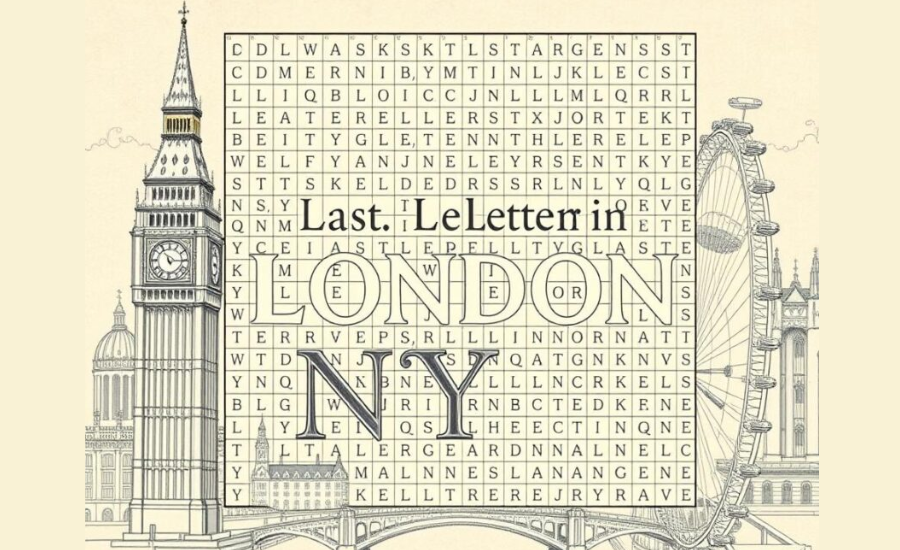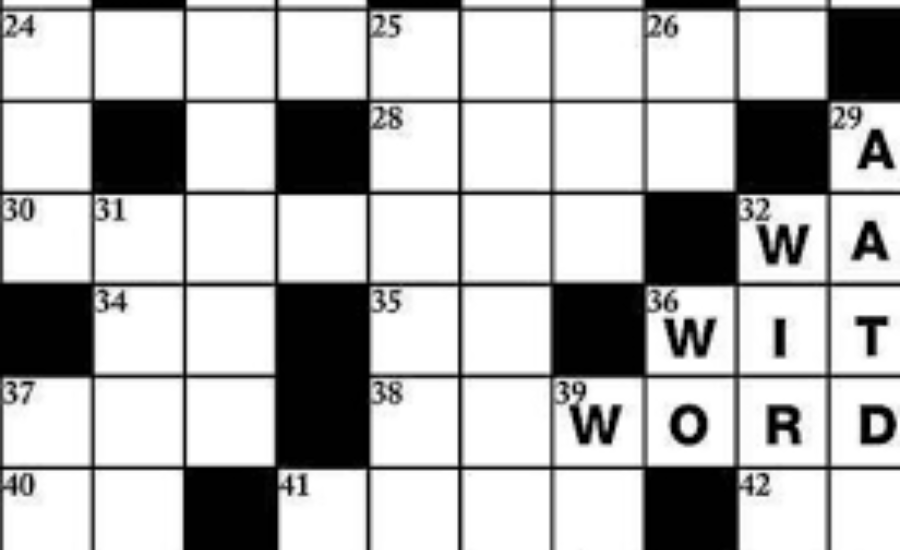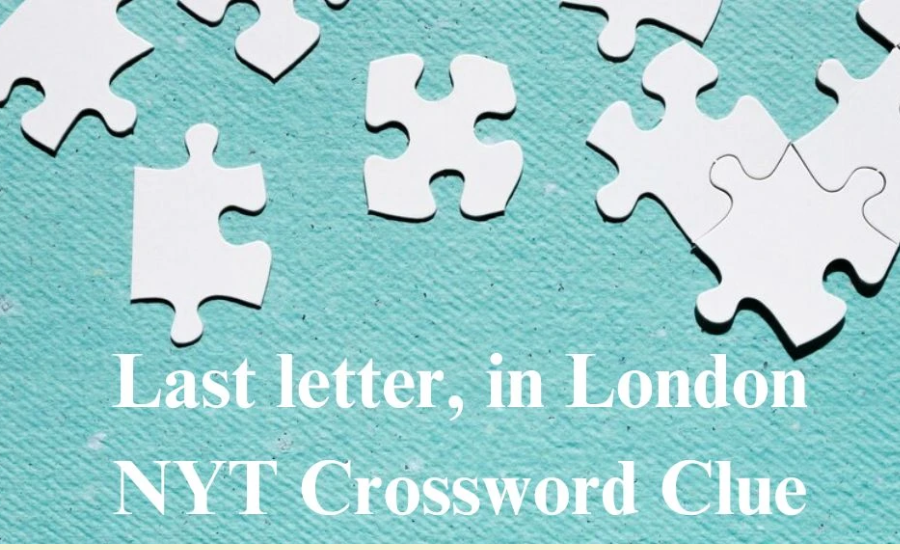Crossword puzzles have captivated puzzle enthusiasts for generations, offering a perfect mix of mental stimulation and entertainment. These word challenges are not just a test of vocabulary but also an opportunity to engage in creative problem-solving. Whether you’re a seasoned crossword solver or a curious beginner, each clue presents a small adventure, inviting you to unlock its hidden meaning.
Among the vast variety of puzzles, The New York Times crossword stands out as a fan favorite. Known for its clever wordplay, challenging hints, and occasional cultural references, it keeps players coming back for more, eager to outsmart the grid day after day.
However, even the best solvers encounter moments of frustration, getting stumped by a particularly tricky clue. Recently, one such riddle has caught the attention of many: “Last Letter in London”. What could it mean? How do you make sense of this cryptic prompt? Let’s explore the possible interpretations and see how we can crack this intriguing puzzle together!
Understanding the Clue: What Does “Last Letter in London” Mean?

This clue requires some careful thinking, as it might contain layers of wordplay or reference a pattern typical of the NYT crossword. Some hints to consider:
- Literal Interpretation: The clue could be asking for the final letter in the word “London,” which is “N.”
- Phonetic or Creative Twist: It may involve a homophone, abbreviation, or a reference to something beyond the obvious—like a famous phrase or literary allusion.
- Crossword Patterns: The phrase might also connect to a larger theme within the puzzle, challenging solvers to think beyond the individual word.
No matter the answer, tackling puzzles like this one demonstrates the joy and frustration that come with crossword solving. Each breakthrough, no matter how small, feels like a personal victory.
Tips for Navigating Tough Crossword Clues
- Think Outside the Box: NYT puzzles often contain puns and wordplay, so don’t always go with the first thought that comes to mind.
- Check the Letters You Already Have: Sometimes the other filled-in answers can give you helpful hints toward solving a stubborn clue.
- Consider Multiple Meanings: Words in crosswords frequently have double meanings, so explore different angles for the clue.
Crossword puzzles offer more than just a game—they’re a mental workout, a chance to learn, and an opportunity to experience the satisfaction of solving. So, the next time you find yourself stuck on a clue like “Last Letter in London,” embrace the challenge. With patience and persistence, you’ll eventually uncover the answer, gaining not just a solution but a deeper appreciation for the art of crossword-solving.
Decoding the Clue: “Last Letter in London” NYT – A Puzzle Within a Puzzle

Crossword clues often present a delightful mix of simplicity and misdirection, teasing solvers with hints that are both straightforward and subtly complex. One clue that has intrigued many is: “Last Letter in London NYT.” While it may appear simple at first, solving it requires both a keen eye and an open mind to avoid overthinking.
Unpacking the Clue: A Simple Answer in Disguise
At its core, the clue asks for the last letter of the word “London.” If you break the word down—L-O-N-D-O-N—you’ll find the final letter is ‘N.’ That’s it! No hidden meanings, obscure literary references, or tricky wordplay. It’s one of those clever crossword hints that seems deceptively easy but can trip you up if you overanalyze.
Many crossword solvers fall into the trap of searching for complex solutions when, in reality, the answer lies in plain sight. These types of clues are designed to reward those who take a step back and observe the puzzle with clarity and simplicity.
Exploring Additional Interpretations: Phonetics and British Influence
While ‘N’ is the literal answer, the clue might also play on the cultural nuances of language, particularly between American and British English. In Britain, the letter ‘Z’ is pronounced as “zed,” which could add another playful twist to the clue. Though the word “London” doesn’t end with a ‘Z,’ this angle invites solvers to think about linguistic differences and how letters are referenced in different parts of the world. This possibility adds an extra layer of intrigue for those familiar with cross-cultural wordplay.
The Real Challenge: Thinking Beyond the Obvious
The magic of crossword puzzles, especially those from The New York Times, lies in their ability to make you think outside conventional boundaries. While the answer to this clue is as simple as the letter ‘N,’ it subtly challenges solvers to resist overcomplicating things. Sometimes, the hardest part of a crossword isn’t the clue itself but our tendency to search for deeper meanings where none exist.
Tips for Solving Deceptive Clues Like This

- Trust the Basics: If a clue seems too simple, try not to overthink it. The simplest solution is often the right one.
- Look for Wordplay: Even when the answer is literal, crosswords love to use hints with a playful twist, as seen with this potential reference to British English phonetics.
- Stay Open to Multiple Interpretations: Clues can be more nuanced than they appear, so keep cultural and linguistic differences in mind.
- Double-Check Your Letters: If you’ve filled in part of the answer through other clues, use those to confirm your final guess.
Why Crosswords Like This Are So Engaging
This clue exemplifies why so many people are drawn to crosswords. It’s not just about vocabulary or trivia—it’s about seeing things from new angles. Crossword puzzles offer a unique blend of mental challenge and creativity, encouraging solvers to stretch their thinking.
The next time you come across a deceptively simple clue like “Last Letter in London,” remember that the answer might be right in front of you. Whether it’s the letter ‘N’ or a playful nod to phonetic quirks, the joy lies in uncovering the answer and appreciating the puzzle’s clever design.
Facts
- Literal Meaning:
The clue refers to the final letter of the word “London”, which is ‘N.’
- Phonetic Play:
The puzzle may hint at phonetic nuances, such as British English where ‘Z’ is pronounced as “zed,” adding a cultural twist.
- Misleading Simplicity:
Crossword puzzles often mislead by appearing simple. The challenge here lies in avoiding overthinking.
- NYT Crossword Appeal:
The New York Times crossword is known for clever wordplay, puns, and occasional cultural references, which challenge solvers’ creativity.
- Theme Considerations:
This clue might connect with a larger theme within the puzzle, making it part of a broader riddle beyond just its literal answer.
FAQs
Q1: What is the correct answer to the clue “Last Letter in London”?
A: The correct answer is ‘N,’ the final letter in the word “London.”
Q2: Could the clue involve wordplay or puns?
A: While the clue seems literal, NYT crosswords often contain puns or wordplay. It may play on linguistic elements like British and American English differences.
Q3: Is this clue part of a larger puzzle theme?
A: It’s possible. Some crossword puzzles use clues connected to a central theme, which requires solvers to think beyond individual answers.
Q4: What makes this clue tricky?
A: Its simplicity can mislead solvers into overcomplicating the answer. Many expect a more complex or obscure solution when the answer is straightforward.
Q5: What strategies can help solve clues like this?
A: Focus on literal meanings first, stay open to multiple interpretations, and use other filled-in letters from the puzzle to guide your solution.
Conclusion
The clue “Last Letter in London” is an excellent example of the subtle complexity found in crossword puzzles, especially those from The New York Times. Although the answer is as simple as the letter ‘N,’ it challenges solvers by tempting them to overthink the solution. Crosswords like these demonstrate the balance between mental stimulation and entertainment, rewarding those who can appreciate both the literal and playful elements of language.
Ultimately, solving puzzles of this nature highlights the joy in small victories—whether it’s spotting a hidden twist or resisting the urge to overanalyze. With persistence, patience, and a bit of creativity, even the most puzzling clues become solvable, leaving solvers with a satisfying sense of accomplishment.
Stay in touch for more updates and alerts visit: GlobeAndMail!
